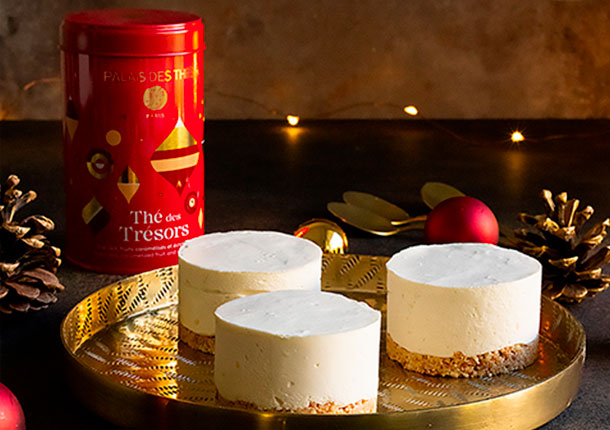Thé des Trésors cheesecake
Serves 4
Dessert
- medium
- 30min
- 24h

Ingredients
- 80 g digestive biscuits (or graham crackers)
- 25 g (2 tablespoons) melted butter
- 200 g cream cheese
- 120 g liquid crème fraîche
- 3 tablespoons
- 2.5 tablespoons caster sugar
- 1+1/3 sheets gelatine
- 4 cake rings (7 cm diameter and 4 cm tall)
Preparation
- Warm the crème fraîche in a small saucepan, keeping it just below the boil
- Fill a paper filter (size L) with tea, place it in a small bowl, and pour the cream over it. Check that the cream is in contact with all of the tea, then cover and steep for 10 minutes
- Wrap with cling film and refrigerate for at least 1 hour or until fully cooled
- Break the biscuits into pieces, put the pieces into a freezer bag, and crush them using a rolling pin or the bottom of a glass. The result should be crumbs, not powder
- Pour the crumbs into a bowl and stir in the melted butter
- Line the cake rings with acetate or waxed paper so that the cheesecakes can be removed cleanly from the rings. If you do not have this type of mould, you can use verrines
- Press the biscuit/butter mixture into the bottom of the 4 rings, then refrigerate while you prepare the cheesecake batter
- Soak the gelatine sheets in a large bowl of cold water for 10 minutes
- Set aside 2 tablespoons of tea-infused crème fraîche and whip the remainder until it forms stiff peaks
- In a large bowl, whisk the cream cheese and sugar together for 3 minutes to soften.
- Wring the water gently from the gelatine sheets. Warm the remaining 2 tablespoons of crème fraîche in the microwave and add the gelatine, which will melt instantly
- Stir immediately with a fork, then pour into the cream cheese mixture. It is important to whisk the batter right away so that the gelatine blends in easily without clumping.
- Fold the whipped cream in delicately to avoid deflating it
- Divide among the cake rings and smooth the surface. Refrigerate for at least 6 hours, or ideally overnight
- Remove the cake rings by running a knife along the inside edge, then serve